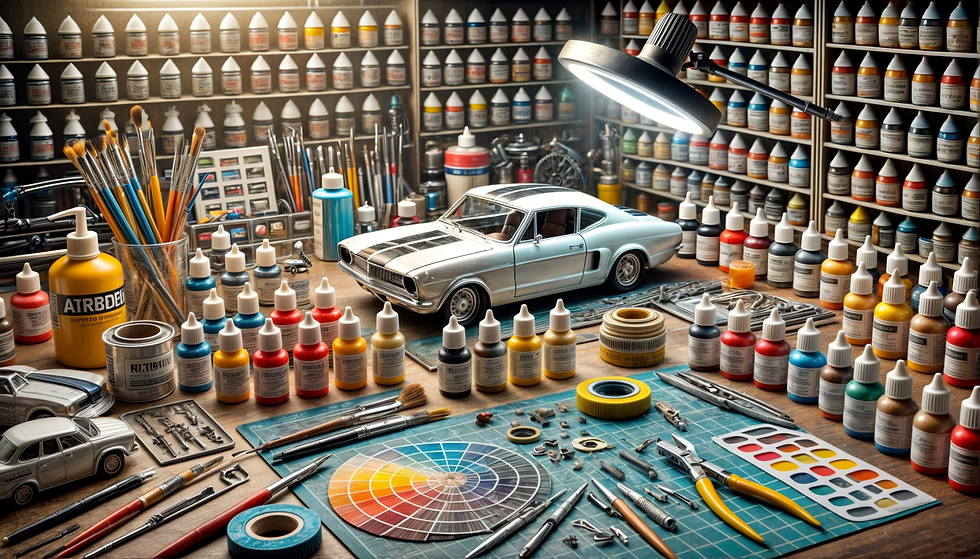Routine Cleaning Techniques to Remove Dust Without Damaging the Paint or Delicate Parts
- Danny Abramovich
- Jan 2
- 3 min read
Updated: Jan 5
Diecast car collectors understand the importance of preserving the look and value of their models. Even when displayed in a case, dust can accumulate on surfaces and settle into crevices. Improper cleaning methods risk scratching paint or breaking small details like mirrors, spoilers, or antennas. Below are best practices for gently removing dust and maintaining the pristine appearance of your diecast collection.

1. Gather the Right Tools
Soft, Lint-Free Cloths: Microfiber cloths are ideal. They trap dust without leaving fibers behind or scratching the paint.
Soft-Bristle Brushes: Small makeup brushes, artist’s paintbrushes (with soft, natural hairs), or dedicated model-cleaning brushes work well for reaching tight spots.
Compressed Air (Optional): Use short bursts of air to dislodge dust from areas where a cloth or brush can’t easily reach. Be cautious not to blow loose parts off or force air at high pressure too close to delicate components.
Pro Tip: Avoid using standard household dusters or paper towels. They can be too coarse and scratch or dull the finish over time.
2. Prepare the Model and Work Area
Wash Your Hands or Wear Gloves: Oils from your fingers can leave smudges or worsen existing dust.
Secure Workspace: Place your model on a stable, clean surface. Lay down a soft mat or cloth to prevent slipping and protect paint if the car accidentally shifts.
Good Lighting: Proper illumination helps you see dust in every nook and cranny.
3. Start with a Gentle Dust-Off
Light Brushing: Use a soft-bristle brush to sweep away loose dust. Gently work in one direction so you’re not just redistributing dust around.
Microfiber Wipe: Lightly wipe the body, roof, and windshield areas with the microfiber cloth. Apply minimal pressure to avoid pressing dust particles into the paint.
Pro Tip: Be especially cautious around decals, badges, and small protruding parts. Applying too much force can lift decals or snap off details.
4. Use Compressed Air with Care
Short Bursts: Aim the nozzle a few inches away and spray lightly in quick bursts. This prevents moisture from forming on the surface and reduces the risk of pushing dust deeper into crevices or dislodging small components.
Angle Matters: Move the nozzle around to approach different angles, ensuring dust is actually removed and not just shifted around.
5. Spot Checks and Stubborn Dust
Precision Tools: If dust remains in vents, grilles, or panel gaps, switch to a smaller, detail-specific brush or a cotton swab.
Light Dabbing: For tight areas, gently dab—rather than rub—the surface to lift dust without creating swirl marks.
6. Wiping Down Windows and Mirrors
Gentle Motion: These areas scratch easily, so keep motions soft and linear rather than circular.
Dedicated Cloth or Section: Use a separate part of your microfiber cloth for windows to avoid transferring dust from the body to clear parts.
No Harsh Cleaners: Water or a diluted, model-safe solution is often enough if fingerprints or smudges appear. Avoid glass cleaners that may be too harsh for plastic.
7. Finishing Touches
Inspect Under Good Light: Check paint for swirl marks or leftover dust.
Re-Position Loose Parts: If you’ve removed wheels or openable parts for cleaning, ensure everything is back in place properly.
Final Polish (Optional): If desired, lightly buff the model with a fresh microfiber cloth to enhance the shine. This step isn’t necessary every time, but it can restore a showroom finish.
8. Regular Maintenance
Frequency: A quick dusting every couple of weeks (or whenever you notice build-up) will prevent heavy accumulation.
Protective Display Cases: While not foolproof, cases significantly reduce the amount of dust that settles on your collection.
Proper Storage: Keep models away from direct sunlight and high-humidity areas, as these factors can worsen paint deterioration and attract more dust and debris.
Final Thoughts
Regular, gentle cleaning is essential to preserve the look and value of diecast models. By using the right tools—soft brushes, microfiber cloths, and occasional bursts of compressed air—you’ll remove dust effectively and protect even the most delicate details. Establishing a consistent routine keeps your collection looking its best and ensures that every time you admire your diecast display, you’ll see them sparkling just like the day you bought them.




Comments